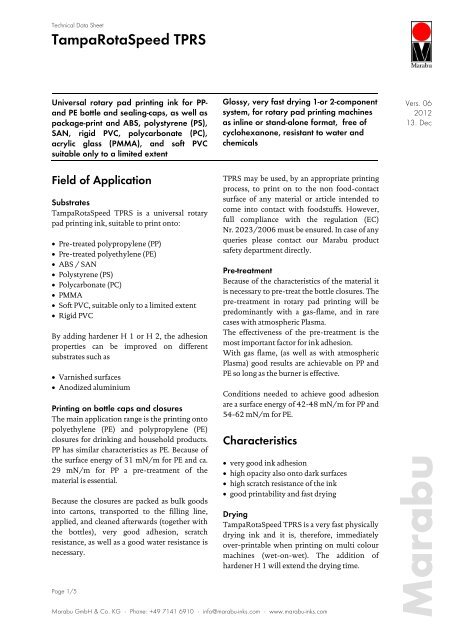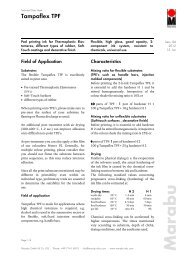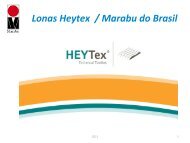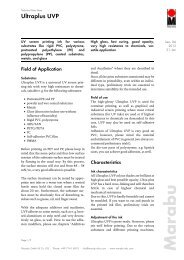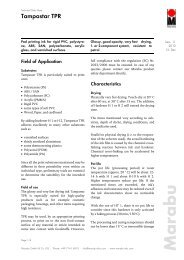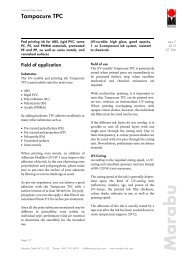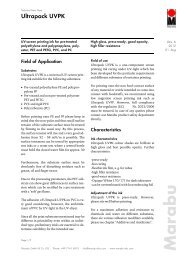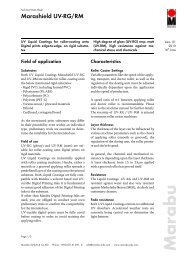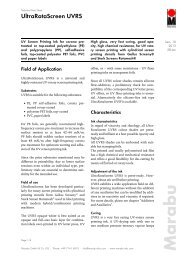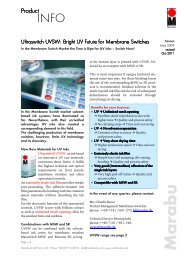TampaRotaSpeed TPRS - Marabu Printing Inks
TampaRotaSpeed TPRS - Marabu Printing Inks
TampaRotaSpeed TPRS - Marabu Printing Inks
You also want an ePaper? Increase the reach of your titles
YUMPU automatically turns print PDFs into web optimized ePapers that Google loves.
Technical Data Sheet<br />
<strong>TampaRotaSpeed</strong> <strong>TPRS</strong><br />
Universal rotary pad printing ink for PPand<br />
PE bottle and sealing-caps, as well as<br />
package-print and ABS, polystyrene (PS),<br />
SAN, rigid PVC, polycarbonate (PC),<br />
acrylic glass (PMMA), and soft PVC<br />
suitable only to a limited extent<br />
Glossy, very fast drying 1-or 2-component<br />
system, for rotary pad printing machines<br />
as inline or stand-alone format, free of<br />
cyclohexanone, resistant to water and<br />
chemicals<br />
Vers. 06<br />
2012<br />
13. Dec<br />
Field of Application<br />
Substrates<br />
<strong>TampaRotaSpeed</strong> <strong>TPRS</strong> is a universal rotary<br />
pad printing ink, suitable to print onto:<br />
• Pre-treated polypropylene (PP)<br />
• Pre-treated polyethylene (PE)<br />
• ABS / SAN<br />
• Polystyrene (PS)<br />
• Polycarbonate (PC)<br />
• PMMA<br />
• Soft PVC, suitable only to a limited extent<br />
• Rigid PVC<br />
By adding hardener H 1 or H 2, the adhesion<br />
properties can be improved on different<br />
substrates such as<br />
• Varnished surfaces<br />
• Anodized aluminium<br />
<strong>Printing</strong> on bottle caps and closures<br />
The main application range is the printing onto<br />
polyethylene (PE) and polypropylene (PE)<br />
closures for drinking and household products.<br />
PP has similar characteristics as PE. Because of<br />
the surface energy of 31 mN/m for PE and ca.<br />
29 mN/m for PP a pre-treatment of the<br />
material is essential.<br />
Because the closures are packed as bulk goods<br />
into cartons, transported to the filling line,<br />
applied, and cleaned afterwards (together with<br />
the bottles), very good adhesion, scratch<br />
resistance, as well as a good water resistance is<br />
necessary.<br />
Page 1/5<br />
<strong>TPRS</strong> may be used, by an appropriate printing<br />
process, to print on to the non food-contact<br />
surface of any material or article intended to<br />
come into contact with foodstuffs. However,<br />
full compliance with the regulation (EC)<br />
Nr. 2023/2006 must be ensured. In case of any<br />
queries please contact our <strong>Marabu</strong> product<br />
safety department directly.<br />
Pre-treatment<br />
Because of the characteristics of the material it<br />
is necessary to pre-treat the bottle closures. The<br />
pre-treatment in rotary pad printing will be<br />
predominantly with a gas-flame, and in rare<br />
cases with atmospheric Plasma.<br />
The effectiveness of the pre-treatment is the<br />
most important factor for ink adhesion.<br />
With gas flame, (as well as with atmospheric<br />
Plasma) good results are achievable on PP and<br />
PE so long as the burner is effective.<br />
Conditions needed to achieve good adhesion<br />
are a surface energy of 42-48 mN/m for PP and<br />
54-62 mN/m for PE.<br />
Characteristics<br />
• very good ink adhesion<br />
• high opacity also onto dark surfaces<br />
• high scratch resistance of the ink<br />
• good printability and fast drying<br />
Drying<br />
<strong>TampaRotaSpeed</strong> <strong>TPRS</strong> is a very fast physically<br />
drying ink and it is, therefore, immediately<br />
over-printable when printing on multi colour<br />
machines (wet-on-wet). The addition of<br />
hardener H 1 will extend the drying time.<br />
<strong>Marabu</strong> GmbH & Co. KG ⋅ Phone: +49 7141 6910 ⋅ info@marabu-inks.com ⋅ www.marabu-inks.com<br />
<strong>Marabu</strong>
Technical Data Sheet<br />
<strong>TampaRotaSpeed</strong> <strong>TPRS</strong><br />
The drying times vary according to substrate,<br />
depth of cliché, drying conditions, and the<br />
auxiliaries used.<br />
Pot life<br />
The pot life (processing period) at room<br />
temperature (approx. 20° C) will be about 8-<br />
10h with hardener H 1. Higher temperatures<br />
during the processing reduce the pot life. If the<br />
mentioned times are exceeded, the ink's<br />
adhesion and resistance may be reduced even if<br />
the ink printing characteristics show no<br />
noticeable change.<br />
The processing and curing temperature should<br />
not be lower than 15° C as irreversible damage<br />
can occur. Also avoid high humidity for several<br />
hours after printing as the hardener is sensitive<br />
to humidity.<br />
Fade resistance<br />
Only pigments of high fade resistance are used<br />
for the <strong>TampaRotaSpeed</strong> <strong>TPRS</strong> range. Shades<br />
mixed by adding overprint varnish or other<br />
colour shades, especially white, have a reduced<br />
fade and weather resistance dependant upon<br />
their mixing ratio. Fade resistance also<br />
decreases if the printed ink film thickness is<br />
reduced.<br />
The pigments used are resistant to solvents and<br />
plasticizers.<br />
Stress resistance<br />
After proper and thorough drying, the ink film<br />
exhibits outstanding adhesion as well as rub,<br />
scratch, and block resistance.<br />
In some cases, surface stability as well as<br />
adhesion and resistance to solvents may be<br />
improved by adding 10% Hardener H 1.<br />
Even if <strong>TampaRotaSpeed</strong> <strong>TPRS</strong> seems to be dry<br />
a few minutes after printing, it is<br />
recommended to carry out resistance tests no<br />
earlier than 24 — 48 hours after printing.<br />
Page 2/5<br />
Ink adjustment<br />
<strong>Printing</strong> onto polypropylene closures:<br />
- <strong>TPRS</strong> plus max. 20% thinner<br />
• TPV (normal)<br />
• TPV 2 (fast)<br />
• TPV 3 (slow)<br />
- for printing onto re-ground polymer the<br />
addition of 10% hardener H 1 to the ink is<br />
usually necessary.<br />
<strong>Printing</strong> onto polyethylene bottle closures:<br />
- <strong>TPRS</strong> plus max. 20% thinner<br />
- <strong>TPRS</strong> colour inks + 15% hardener H 1<br />
- <strong>TPRS</strong> varnish 910 + 10% hardener H 1<br />
- to receive a maximum water resistance, the<br />
<strong>TPRS</strong> must be over-coated with the varnish<br />
TPU 910 + 30% hardener H 1.<br />
For printing on PE closures an addition of 15%<br />
hardener into the ink is necessary to achieve<br />
good adhesion.<br />
For higher requirements concerning water<br />
resistance we recommend to overprint the<br />
varnish TPU 910. Please note that compared to<br />
<strong>TampaRotaSpeed</strong> <strong>TPRS</strong> (can be used as a 1 or 2<br />
component system) TPU must be used as a 2<br />
component system. The overprint need to be<br />
done wet-on-wet.<br />
Range<br />
Basic shades - System Tampacolor<br />
920<br />
922<br />
924<br />
926<br />
930<br />
932<br />
934<br />
936<br />
940<br />
Lemon<br />
Light Yellow *<br />
Medium Yell.<br />
Orange<br />
Vermilion *<br />
Scarlet Red<br />
Carmine Red<br />
Magenta*<br />
Brown<br />
950<br />
952<br />
954<br />
956<br />
960<br />
962<br />
970<br />
(* semi-transparent/ transparent)<br />
<strong>Marabu</strong> GmbH & Co.KG ⋅ Phone: +49 7141 6910 ⋅ info@marabu-inks.com ⋅ www.marabu-inks.com<br />
980<br />
Violet*<br />
Ultramarine blue*<br />
Medium Blue<br />
Brilliant Blue*<br />
Blue Green<br />
Grass Green *<br />
White<br />
(semi-gloss)<br />
Black<br />
<strong>Marabu</strong>
Technical Data Sheet<br />
<strong>TampaRotaSpeed</strong> <strong>TPRS</strong><br />
High-opaque shades<br />
122 Light Yellow<br />
130 Vermilion<br />
152 Ultramarine blue<br />
162 Grass Green<br />
Press-ready silver<br />
191 Silver<br />
All shades are intermixable. Mixing with other<br />
ink types or auxiliaries must be avoided in<br />
order to maintain the special characteristics of<br />
this outstanding ink range.<br />
All basic shades are included in our <strong>Marabu</strong>-<br />
ColorFormulator (MCF). They build the basis<br />
for the calculation of individual colour<br />
matching formulas, as well as for shades of the<br />
common colour reference systems HKS ® ,<br />
PAN-TONE ® , and RAL ® . All formulas are<br />
stored in the <strong>Marabu</strong>-Color Manager software.<br />
The high-opaque formulas are additionally<br />
available marked with + + behind the reference<br />
name. These formulas have been developed by<br />
using the System Tampacolor formulas for<br />
basic and high-opaque shades, excluding the<br />
semi-transparent, resp. transparent shades.<br />
The pigments used in the above mentioned<br />
standard shades, based on their chemical<br />
structure, correspond to the EEC regulations<br />
EN 71/part 3, safety of toys - migration of<br />
specific elements. All colours are suited for<br />
printing onto toys.<br />
Additives<br />
Clears<br />
910 Overprint Varnish<br />
Page 3/5<br />
Auxiliaries<br />
Thinner:<br />
TPV<br />
TPV 2, fast thinner<br />
TPV 3, slow thinner<br />
TPV 7<br />
Hardener: H 1<br />
Mixing ratio: 10 p. ink :1,5 p. hardener<br />
Retarder: SV 1<br />
VP, Retarder Paste<br />
Matting agent: MP, Matting Powder<br />
Antistatic Paste: AP<br />
Opaque Paste: OP 170<br />
<strong>Printing</strong> modifier: ES, addition max.1%<br />
It is generally sufficient to adjust the printing<br />
viscosity by adding 5—15% TPV if Continua<br />
/Big Wheel printers are being used, or 10—<br />
20% TPV 2 (or alternatively TPV 7) for<br />
Rotoprint / Mini Wheel printers, dependant<br />
upon the type of machine, printing speed,<br />
ambient temperature, and cliché depth.<br />
Thinner TPV 2 or TPV 7can be used for fast<br />
printing, TPV 3 for slow printing<br />
requirements.<br />
For the printing of very fine motives, a mixture<br />
of thinner TPV and TPV 3 (SV 1) or TPV 3<br />
should be used. An excessive addition may<br />
result in ink transfer problems.<br />
Attention<br />
For an ink mixture containing retarder, only<br />
thinner (TPV) should be used for additional<br />
thinning during the print run.<br />
By adding Matting Powder MP, the gloss effect<br />
of the ink is reduced to a silky or semi-matt<br />
finish. The addition of 2-4% Matting Powder<br />
MP (in case of 970 White, max. 2%) will not<br />
significantly influence the resistance of the ink<br />
but may reduce opacity.<br />
<strong>Marabu</strong> GmbH & Co.KG ⋅ Phone: +49 7141 6910 ⋅ info@marabu-inks.com ⋅ www.marabu-inks.com<br />
<strong>Marabu</strong>
Technical Data Sheet<br />
<strong>TampaRotaSpeed</strong> <strong>TPRS</strong><br />
By adding Opaque Paste 170, the opacity of<br />
colour shades can be significantly increased<br />
without significantly influencing the chemical<br />
or abrasion resistance. Maximum quantity to be<br />
added is 15%. OP 170 is not suitable for adding<br />
to white shades.<br />
<strong>Printing</strong> Modifier ES contains silicone. It can be<br />
used to rectify flow problems on critical<br />
substrates by adding up to 1% by weight to the<br />
ink. If an excessive amount is added, flow<br />
problems are increased, and adhesion may be<br />
reduced, especially when overprinting.<br />
Cleaning<br />
<strong>Printing</strong> pads<br />
Pads in use have normally a hardness between<br />
30-55 Shore A. If pad cylinders are self-cast, an<br />
exact rotation must be guaranteed.<br />
<strong>Printing</strong> machines<br />
<strong>TampaRotaSpeed</strong> <strong>TPRS</strong> can be used for rotary<br />
pad printing machines in inline-construction,<br />
or for printing machines in satellite<br />
constructions (“big wheel”). Depending on the<br />
kind and use of the machine, the amount and<br />
type of the used thinner must be readjusted.<br />
For manual cleaning of containers, clichés, and<br />
tools our cleaner UR 3 (flash point 42° C) or<br />
UR 4 (flash point 52°C) can be used.<br />
Clichés<br />
In rotary pad printing with <strong>TPRS</strong>, good results<br />
were achieved with a pad cylinder diameter of<br />
100 mm or 200 mm. We recommend a cliché<br />
depth of 22-30µm for a half tone cliché and<br />
20-22µm for a non half tone cliché (open<br />
etched).<br />
With steel die plates, halftone films are used<br />
with large images to avoid the doctor blade<br />
falling into the etched area.<br />
Doctor blade<br />
Doctor blades of tempered steel are either<br />
ground from both sides 0,5 mm or specially<br />
ground from one side 0,3 mm.<br />
Page 4/5<br />
Recommendation<br />
The ink should be stirred well before printing.<br />
To protect the ink in opened containers against<br />
excessive drying, it can be carefully covered<br />
with a layer of thinner which can then be later<br />
stirred into the ink prior to printing.<br />
Labelling<br />
For our ink type <strong>TampaRotaSpeed</strong> <strong>TPRS</strong> and<br />
its additives and auxiliaries, there are current<br />
Material Safety Data Sheets available according<br />
to EC-regulation 1907/2006 informing in<br />
detail about all relevant safety data including<br />
labelling according to the present EEC<br />
regulations as to health and safety labelling<br />
requirements. Such health and safety data may<br />
also be derived from the respective label.<br />
The ink has a flash point between 45° C and<br />
55° C.<br />
<strong>Marabu</strong> GmbH & Co.KG ⋅ Phone: +49 7141 6910 ⋅ info@marabu-inks.com ⋅ www.marabu-inks.com<br />
<strong>Marabu</strong>
Technical Data Sheet<br />
<strong>TampaRotaSpeed</strong> <strong>TPRS</strong><br />
Note<br />
Our technical advice whether spoken, written,<br />
or through test trials corresponds to our<br />
current knowledge to inform about our<br />
products and their use. This is not meant as an<br />
assurance for certain properties of the products<br />
nor their suitability for each application.<br />
You are, therefore, obliged to conduct your<br />
own tests with our supplied products to<br />
confirm their suitability for the desired process<br />
or purpose. The selection and testing of the ink<br />
for specific application is exclusively your<br />
responsibility.<br />
Should, however, any liability claims arise,<br />
they shall be limited to the value of the goods<br />
delivered by us and utilized by you with<br />
respect to any and all damages not caused<br />
intentionally or by gross negligence.<br />
Page 5/5<br />
<strong>Marabu</strong> GmbH & Co.KG ⋅ Phone: +49 7141 6910 ⋅ info@marabu-inks.com ⋅ www.marabu-inks.com<br />
<strong>Marabu</strong>


